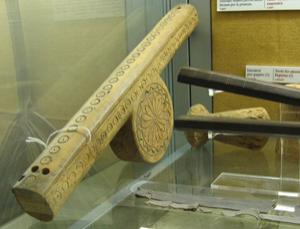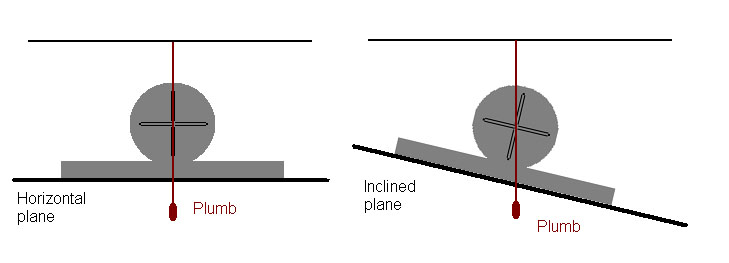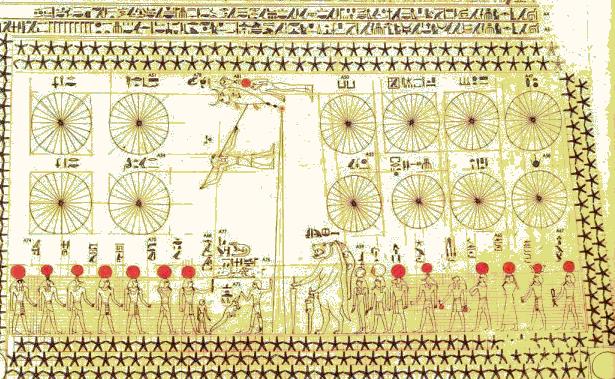
Did the ancient Egyptians build their impressive monuments with the help of the world's first protractors? A paper published last week on the physics preprint server suggests that the mysterious object in this picture, found in the tomb of an ancient Egyptian architect, could have been used as one.
The architect was called Kha, and he lived during Egypt's 18th Dynasty, around 1400 BC (shortly before the reign of Tutankhamun). His intact tomb was discovered by the Italian archaeologist Ernesto Schiaparelli in 1906, located in Deir el-Medina, which was a village for the workmen who constructed the royal tombs of that time.
Kha was buried with his surveying instruments, including cubit measuring rods (one of them foldable) and an instrument that looks like a modern set square. It would have been stood up like an A frame, with a plumb line hanging down from the point of the A, to show whether a surface was level.
Then there's the strange wooden item pictured, with a circular section bulging out of a straight bar. It is hollow inside and has a hinged lid, so it seems to be a case for something, although it was found empty. Schiaparelli thought it held a levelling instrument. The Egyptian museum in Turin, where the objects are now on display, identifies it as the case for a balance scale.
But Amelia Sparavigna, a physicist at the Politecnico di Torino in Turin, Italy, now suggests that whatever the case originally held, it could also have functioned as the world's earliest known protractor. Sparavigna has applied her physics expertise to archaeology before. For example, she has used an imaging processing method developed for studying liquid crystals to identify archaeological features in satellite images, and has investigated the symmetry in ancient seals.
I've written a short story for New Scientist on Sparavigna's latest paper, but here's the story in a bit more detail. She has analysed the decoration on the circular section of Kha's mysterious case. It includes a rose pattern with 16 evenly spaced leaves, and a circular zigzag with 36 corners. Both numbers, 16 and 36, were significant to the ancient Egyptians. The fraction one-sixteenth features in a calculus system the Egyptians used, says Sparavigna, and they identified 36 star groups called the decans, which later formed the basis of a star clock. She suggests the object was "a protractor instrument with two scales, one based on Egyptian fractions, the other based on decans".

She thinks Kha could have used it for measuring the angle of a slope or wall, or even to orient temples of tombs to specific astronomical directions. If you placed the straight portion of the instrument on the slope and then you could read off the appropriate angle from vertical using a hanging plumb line - she was kind enough to send me this graphic of how she sees it working.
I asked Kate Spence, an archaeologist at the University of Cambridge who specialises in ancient Egyptian architecture, what she makes of the idea. She describes the idea was "intriguing" but is very sceptical. She says that ancient Egyptian measuring instruments tend to be carefully made and precise with neat labels. "They look like measuring instruments," she says. In contrast, the design on Kha's case isn't particularly even and looks decorative. What's more, to use the instrument as Sparavigna suggests would involve resting it on its hinged lid, which is slightly rounded. "If it was to be a surveying insturment, the solider and squarer the faces of the flat bit the better," she says.
There's no doubt that Egyptian architects and engineers were capable of very precise work, however. Spence says that if they wanted to, architects could orient a building to within a few sixtieths of a degree. But they wouldn't necessarily have needed a protractor. Instead, the Egyptians expressed slopes and angles in terms of proportional ratios - for example you might create a 45-degree angle by measuring along two cubits and up two cubits, rather than specifying the angle itself.

The Egyptians knew how to divide up a circle too. On the ceiling of the tomb of another 18th Dynasty architect called Senmut, there is a series of circles (pictured). These have been divided into 24 equal sections by drawing squares around the circles, and seem to be associated with the hours in the day. "They look mathematical, the case doesn't," says Spence.
Sparavigna stands by her suggestion, and I think it's a fascinating idea, although I do find Spence's arguments quite convincing. So, Kha's case aside, when did protractors first appear? I asked Tracey Rihll, an expert in Greek and Roman technology at Swansea University and she said that there's a Roman example of a surveying instrument similar to a protractor in the Aquincum museum in Budapest.
But it may have been the Greeks who invented them. The first-century astronomer Ptolemy described how to make a 360-degree ring, and a 90-degree quadrant, so it was apparently routine by then to make instruments to measure angles. And of course the Antikythera mechanism, which dates from the 2nd century BC, has a 360-degree dial on it too.
Thanks to Sparavigna for sending me the picture of Kha's case (copyright Jane Maria Hamilton).